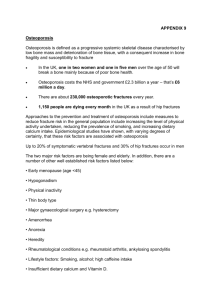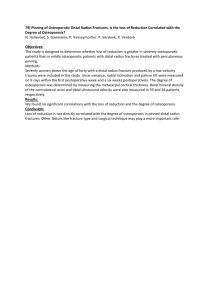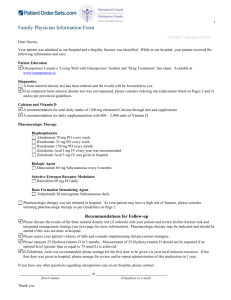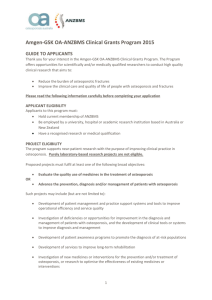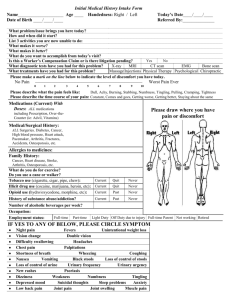Descriptive Epidemiology Project Paper: Osteoporosis
advertisement
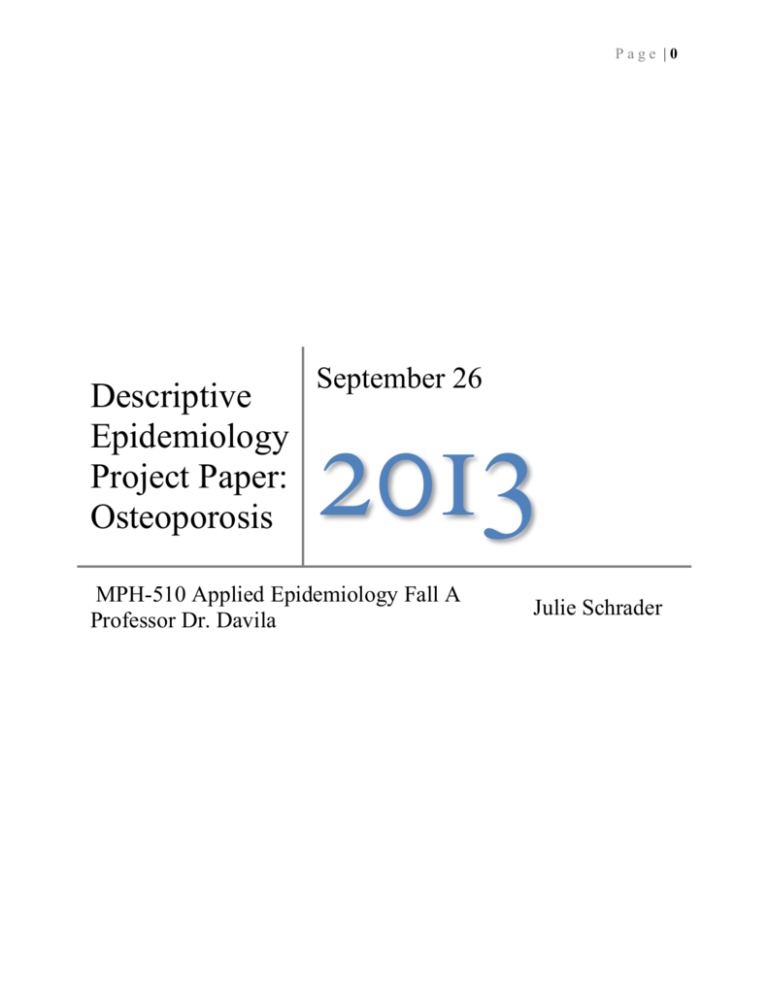
Page |0 Descriptive Epidemiology Project Paper: Osteoporosis September 26 2013 MPH-510 Applied Epidemiology Fall A Professor Dr. Davila Julie Schrader Page |1 Osteoporosis is known as a disease that affects older adults, in the United States alone 40 million people have osteoporosis or are at high risk for Osteoporosis and 200 million worldwide are affected (International Osteoporosis Foundation, n.d.). Osteoporosis that literally means ‘porous bones’ affects bones by thinning and weakening the mass and/or density of the bones to breaking points (NIH Senior health, 2013). It is caused when the body does not make new bone or existing bone is reabsorbed. The high number of people with Osteoporosis makes it the most common bone disease which mostly affects post-menopausal women more than men; however, either are susceptible (PubMed Health, 2012). Thus making osteoporosis a significant concern in the United States for both men and women. With the growing population of older adults the incidence rate will be increasing drastically. The agents of infectious disease are easily found however since osteoporosis is a chronic disease there are several agents that cause Osteoporosis: Genetic factors, nutrition, exercise, and menstrual function. Those are the four main causes of Osteoporosis for men and women (Medscape, n.d.). Genetic factors are a concern for women because young men tend to have a higher bone mass than younger women. This is one reason why women have a higher risk than men to have Osteoporosis. Nutrition plays an important role in a way of calcium, higher calcium intake leads to lower hip fractures in older adults. Recommended Intake is listed in the table below (Table 1) (MedScape, n.d.).Another cause of Osteoporosis has been linked to exercise even more specifically to weight bearing exercises. It has been found that these kinds of exercise have increased bone density and mass. The last cause is in women and is concerning the menstrual cycle. The lack of a menstrual cycle is a concern along with some birth controls that lower Page |2 estrogen levels. These agents have been studied to affect bone loss and have an effect on fractures of the bone. The morbidity and mortality rates are not easily defined because of the wide scope of Osteoporosis many numbers tend to differ. The International Osteoporosis Foundation found that twenty-four percent of women and 33% of men die within one year after a hip fracture (priority medicine, 2004). The morbidity rate ranges because Osteoporosis usually goes undiagnosed until a fracture actually occurs. One of the most important factors affected by Osteoporosis is a person’s quality of life which can lead to the following: anxiety and depression reduced self-image limitations in the ability to work and enjoy leisure activities acute or chronic pain difficulties in performing the activities of daily life loss of independence Changes in relationships with family and friends. These in turn lead to higher mortality rates. The prevalence of Osteoporosis is shown in figure 4 below. These are from 2002-2020 showing the vast mortality rate that is coming our way. Age is the one of the most important factors in descriptive epidemiology (Friis & Sellers, 2014). With bone loss happening as we age and after menopause this is an age related disease that affects mostly older adults, from 2% at 50 years to more than 25% at 80 years in women (Osteoporosis, n.d.). Secondary Osteoporosis effects people at any age and can affect people at a young age. The first occurrences of osteoporosis factures are usually between the ages of 50-59 years of age (Osteoporosis-Medscape, n.d.). As I have mentioned women tend to have higher Page |3 occurrence because of the postmenopausal changes that their bones go though and that they live one third of their lives after these changes take place (WHO, 1999). A ratio of 4 females to one male is said to be diagnosed with Osteoporosis (Osteoporosis-Medscape, n.d.) Below is a table that expresses the ethnic groups that have the highest prevalence of Osteoporosis and low bone mass’s you can see from table 2 non-Hispanic and Asian ethnicity have the highest risk of osteoporosis. Furthermore in the United States figure 5 shows a state-by –state map of percentages of osteoporosis and bone density. For some reason Utah and Washington State have over 60% listed from the 2002 census. The National Osteoporosis foundation did not give details of why these two states were reported above the other states. “Better-educated subjects tended to be taller and to have a lower body mass index and higher intakes of dietary energy, calcium, phosphorus, plant protein, soy protein, and fresh fruits. Higher education is also associated with a younger age at menarche and a shorter duration of pregnancy and lactation. Only a few individuals drank alcohol more than once per week (3.7–4.8 percent) or were smokers (≥1 cigarette/week for 3 months) (<2 percent).” (Clin. Endocrinol. Metab., 2013) As in other chronic conditions along with Osteoporosis it is found that higher education levels and higher income of persons tend to have a lower risk because of the knowledge they have about prevention around Osteoporosis. Some other risk factors that are non-genetic that affect osteoporosis is: Low body mass index smoking high alcohol intake (3 or more drinks per day) Eating disorders Gastrointestinal surgery Page |4 Steroids and other medications These choices are voluntary and can give a person higher risk of osteoporosis. People who make these lifestyle choices above are likely to have bone fractures in later years of their life. Osteoporosis tends to not be cyclic or seasonal because the trends do not change over seasons of the year. It is not a point epidemic and is not even truly defined as epidemic either even though the occurrence is clearly in excess of normal expectancy (Friis & Seller, 2014). Osteoporosis can be defined as a secular variation because there has been changed over a period of time in this case decades. You can see also from figure 6 the slight incline from 1970-1995 (Prevalence of osteoporosis, n.d.). The hypotheses that have been proposed to explain the increase in prevalence have been surrounded by the lifestyle of persons. There are several differences in the lifestyles in the different countries that are affecting the higher prevalence in Caucasians and Asians; such as, diet, sedentary lifestyle, smoking, race, and medications (Marcus, R., 2001). There needs to be additional research around prevention based on the projections for 2050 with an increase of 240% for women and 310% in men (International Osteoporosis foundation, n.d.) Men tend to not be targeted for prevention in this disease, which would be the reason for the higher percentage of increase. Also the high increase the Eastern countries are due to increases in the number of the elderly in Asia, Africa and South America (World Health Organization, 1999). (See Table3). There is also an increasing need for further research in children because of the increasing popular steroid treatment being use on children whom have cancer and diseases such as orthogenesis imperfect (priority medicine, 2004). Also further research needs to be done in the diagnosing of Osteoporosis because it is an Page |5 asymptomatic disease that goes undiagnosed by many developed countries even (Osteoporosis current trends, 2006). One other gap is in the knowledge of how much the genetic factors weigh towards the non gentic factors. There seems to be little information on how much of a role non-genetic risk factors play (Spangler, n.d). Even though Osteoporosis is the most common bone disease worldwide there is a problem with standardizing the epidemiology because of the testing and underutilization of testing therefore comparisons of each study are hard to complete and compile to help solve this soon to be epidemic (Standardizing the descriptive epidemiology of osteoporosis, 2013). Page |6 Table 1: Age Calcium Vitamin (Years) (mg) D (IU) 8-Mar 800 200 17-Sep 1300 200 18-50 1000 400 51-70 1200 400 > 70 1200 600 Table 2: % % Estimated Estimated to to have have low osteoporosis bone mass Non-Hispanic Women 20 52 white; Asian Men 7 35 * Non-Hispanic Women 5 black Men 4 19 Hispanic Women 10 49 Men 3 23 Source: National Osteoporosis Foundation. Fast facts. Available at: http://www.nof.org/node/40. Accessed: February 16, 2012. * Low bone density is present in an additional 35% of black women, increasing their risk of developing osteoporosis. Sex (age Race/Ethnicity ≥50 y) Page |7 \ Table 3: Figure 4: Page |8 Figure 5: Figure 6: Page |9 References: Associations Between Age at Menarche and Menopause With Cardiovascular Disease, Diabetes, and Osteoporosis in Chinese WomenJ. Clin. Endocrinol. Metab. (2013) 98 (4): 1612-1621 Epidemiology | International Osteoporosis Foundation. (n.d.). International Osteoporosis Foundation | Bone Health. Retrieved September 24, 2013, from http://www.iofbonehealth.org/epidemiology Epidemiology of Osteoporosis. (n.d.).MedScape. Retrieved September 24, 2013, from www.medscape.org/viewarticle/502984_5 Marcus, R. (2001). Osteoporosis (2nd ed.). San Diego, CA: Academic Press. NIHSeniorHealth: Osteoporosis - What Is Osteoporosis?. (2013). NIHSeniorHealth Home Page. Retrieved September 24, 2013, from http://nihseniorhealth.gov/osteoporosis/whati OSTEOPOROSIS: BOTH HEALTH ORGANIZATIONS AND INDIVIDUALS MUST ACT NOW TO AVOID AN IMPENDING EPIDEMIC. (1999). World Health Organization. Retrieved September 24, 2013, from www.who.int/inf-pr-1999/en/pr9958.html Osteoporosis . (n.d.). MedScape. Retrieved September 24, 2013, from emedicine.medscape.com/article/330598-overview#a0156 Osteoporosis - overview - National Library of Medicine - PubMed Health. (n2012). National Center for Biotechnology Information. Retrieved September 24, 2013, from http://www.ncbi.nlm.nih.gov/pubmedhealth/PMH0001400/ Osteoporosis: current trends in diagnos... [Bosn J Basic Med Sci. 2006] - PubMed NCBI. (n.d.). National Center for Biotechnology Information. Retrieved September 25, 2013, from http://www.ncbi.nlm.nih.gov/pubmed/1653317 Osteoporosis | Doctor | Patient.co.uk. (n.d.). Symptom Checker, Health Information and Medicines Guide | Patient.co.uk. Retrieved September 25, 2013, from http://www.patient.co.uk/doctor/osteoporosis Prevalence of osteoporosis and incidence of hip fracture in women--secular trends over 30 years. | ReadCube Articles. (n.d.). ReadCube | Free Reference Manager - Academic Software For Research. Retrieved September 26, 2013, from http://www.readcube.com/articles/10.1186/1471-2474-11-48?locale=en Priority Medicines for the Citizens of Europe: Osteoporosis. (2004).oestofound.org. Retrieved September 24, 2013, from archives.who.int/prioritymeds/report/contributions/osteo.doc Standardizing the descriptive epidemiology of osteoporosis: recommendations from the Epidemiology and Quality of Life Working Group of IOF. Kanis JA, Adachi JD, Cooper C, Clark P, Cummings SR,. (n.d.). pub med. Retrieved September 25, 2013, from www.ncbi.nlm.nih.gov/pubmed/23884436 Spangler, F. A. (n.d.). The Genetic Component of Osteoporosis. CSA. Retrieved September 25, 2013, from http://www.csa.com/discoveryguides/archives/osteo.php


